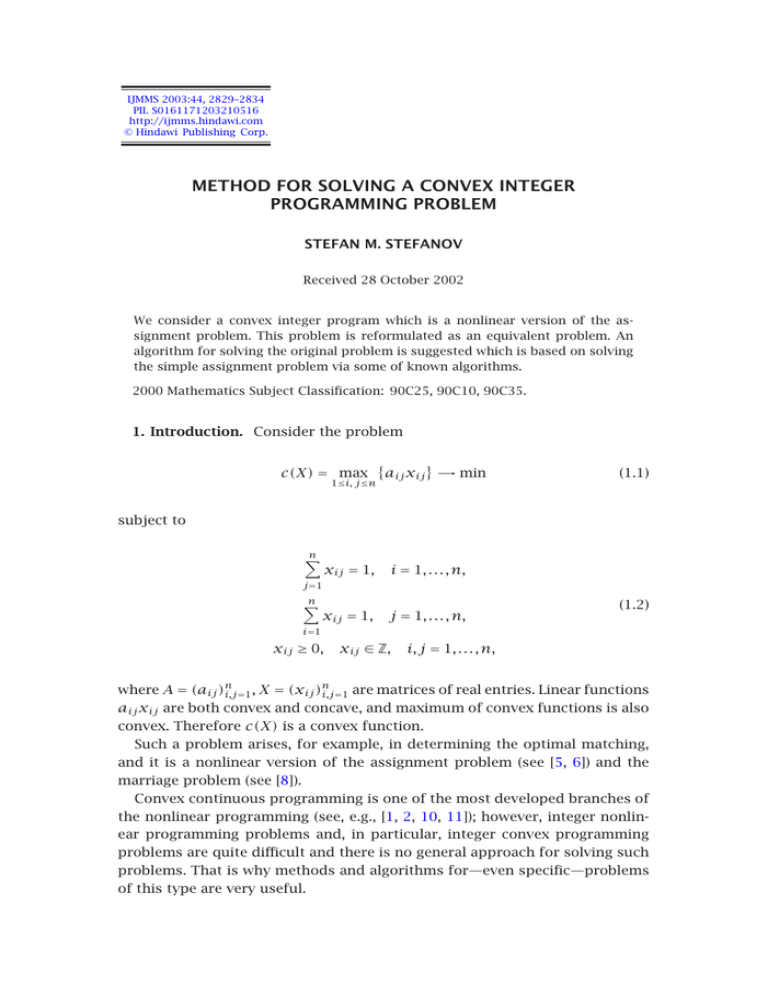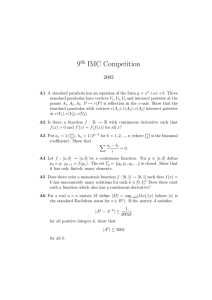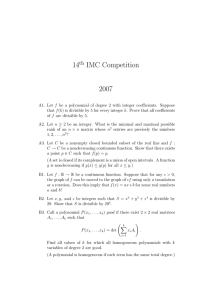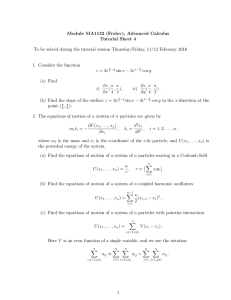METHOD FOR SOLVING A CONVEX INTEGER PROGRAMMING PROBLEM STEFAN M. STEFANOV
advertisement

IJMMS 2003:44, 2829–2834
PII. S0161171203210516
http://ijmms.hindawi.com
© Hindawi Publishing Corp.
METHOD FOR SOLVING A CONVEX INTEGER
PROGRAMMING PROBLEM
STEFAN M. STEFANOV
Received 28 October 2002
We consider a convex integer program which is a nonlinear version of the assignment problem. This problem is reformulated as an equivalent problem. An
algorithm for solving the original problem is suggested which is based on solving
the simple assignment problem via some of known algorithms.
2000 Mathematics Subject Classification: 90C25, 90C10, 90C35.
1. Introduction. Consider the problem
c(X) = max
1≤i, j≤n
aij xij → min
(1.1)
subject to
n
xij = 1,
i = 1, . . . , n,
xij = 1,
j = 1, . . . , n,
j=1
n
(1.2)
i=1
xij ≥ 0,
xij ∈ Z,
i, j = 1, . . . , n,
n
where A = (aij )n
i,j=1 , X = (xij )i,j=1 are matrices of real entries. Linear functions
aij xij are both convex and concave, and maximum of convex functions is also
convex. Therefore c(X) is a convex function.
Such a problem arises, for example, in determining the optimal matching,
and it is a nonlinear version of the assignment problem (see [5, 6]) and the
marriage problem (see [8]).
Convex continuous programming is one of the most developed branches of
the nonlinear programming (see, e.g., [1, 2, 10, 11]); however, integer nonlinear programming problems and, in particular, integer convex programming
problems are quite difficult and there is no general approach for solving such
problems. That is why methods and algorithms for—even specific—problems
of this type are very useful.
2830
STEFAN M. STEFANOV
Denote by Ꮽ the set of all automorphisms {α(i)} of the set N = {i}n
i=1 .
Cardinality of Ꮽ is |Ꮽ| = n!. Denote
µ = min max aiα(i) .
α∈Ꮽ i∈N
(1.3)
It turns out that problem (1.1)-(1.2) is equivalent to the following problem:
find a number µ and α∗ ∈ Ꮽ such that
aiα∗ (i) ≤ µ,
i = 1, . . . , n.
(1.4)
2. Main result. To each real number r , associate via the matrix A the matrix
A = (arij )n
i,j=1 , where
r
0,
arij =
1,
if aij > r ,
if aij ≤ r .
(2.1)
We say that r ∈ F if there exists an α̃ ∈ Ꮽ with
ariα̃(i) = 1,
i = 1, . . . , n,
(2.2)
that is, if the simple assignment problem with a matrix Ar = (arij )n
i,j=1 is solvable,
F = r : ∃α̃ ∈ Ꮽ with ariα̃(i) = 1, i = 1, . . . , n .
(2.3)
Whether r ∈ F or not can be determined, for example, via the algorithm of
Ford and Fulkerson (see [3, 4]) or via the Hungarian method (see [9, 12]).
Theorem 2.1. Let
ν = min aij .
aij ∈F
(2.4)
Then µ = ν.
Proof. (i) From the definition of µ it follows that
n
µ ∈ aij i,j=1 ,
(2.5)
and from the existence of solution α∗ of problem (1.4) (aij ∈ F ) and from (2.1)
it follows that
µ
aiα(i) = 1,
i = 1, . . . , n,
(2.6)
that is, µ ∈ F .
Relations (2.5) and (2.6) imply
µ ≥ ν.
(2.7)
METHOD FOR SOLVING A CONVEX INTEGER PROGRAMMING PROBLEM 2831
(ii) We will prove that µ ≤ ν. From definition of ν it follows that ν ∈ F , that
is, there exists an α ∈ Ꮽ such that
aνiα(i) = 1,
i = 1, . . . , n.
(2.8)
aiα(i) ≤ ν,
i = 1, . . . , n,
(2.9)
From (2.1) it follows that
whence
max aiα(i) ≤ ν.
(2.10)
min max aiα(i) ≤ max aiα(i) ≤ ν,
(2.11)
µ ≤ ν.
(2.12)
i∈N
However,
α∈Ꮽ i∈N
i∈N
that is,
Relations (2.7) and (2.12) imply µ = ν.
3. An algorithm for finding µ. Reindex all entries of the matrix A =
(aij )n
i,j=1 in strictly increasing order; equal elements are considered once:
ai1 j1 < ai2 j2 < · · · < aik jk < · · · < aip jp ,
p ≤ n2 .
(3.1)
Consider the sequence of indexes
1, 2, . . . , k, . . . , p.
(3.2)
We say that k ∈ F ∗ if aik jk ∈ F . Denote by [x] the largest integer less than or
equal to x.
Let
k, k + 1, . . . , k + l,
(3.3)
where k > 0, l ≥ 0, be part of the sequence of the positive integers. The number
[(2k + l)/2] is said to be the average number of sequence (3.3).
Find the average number n1 of the sequence (3.2). Throw away half of the sequence (3.2) for which k ≥ n1 if n1 ∈ F ∗ , and k ≤ n1 if n1 ∈ F ∗ . After that, find
the average number n2 of the remaining sequence (half-sequence of (3.2)) and
similarly throw away its half-sequence. Continue this process until all terms
of the sequence (3.2) are thrown away.
Denote by nk the average number of the sequence obtained from (3.2) after
we have thrown away the respective half-sequences k − 1 times. Denote by m
2832
STEFAN M. STEFANOV
the number of steps necessary for throwing away all elements of sequence
(3.2).
Theorem 3.1. Let
n∗ =
min
nk ∈F ∗ , 1≤k≤n
nk .
(3.4)
{k}.
(3.5)
Then µ = ain∗ jn∗ .
Proof. Let
k∗ =
min
k∈F ∗ , 1≤k≤p
Our purpose is to prove that n∗ = k∗ . From definitions of n∗ , k∗ , and nk it is
obvious that
n∗ ≥ k∗ .
(3.6)
k ∈ F∗
(3.7)
If k ≥ k∗ , then
according to definition of k∗ .
Assume that n∗ > k∗ strictly. Taking into account (3.7), it turns out that
after the mth step of throwing away the respective half-sequence, we have
not thrown away number k∗ from the sequence (3.2), which contradicts the
definition of m (m is the number of steps necessary for throwing away all
elements of sequence (3.2)). Therefore this assumption was wrong, and (3.6)
implies n∗ = k∗ . From definitions of k∗ and ν (Theorem 2.1) it follows that
aik∗ jk∗ ≡ ain∗ jn∗ = ν,
(3.8)
and according to Theorem 2.1 (µ = ν), we have
µ = ain∗ jn∗ .
(3.9)
4. Estimates for µ and m. Denote by b the least element of (3.1) with the
following property: the set of all elements of the matrix A = (aij )n
i,j=1 such
that
aij ≤ b
(4.1)
contains n elements with different indices i and n elements with different
indices j. For a given matrix A, number b can be determined.
METHOD FOR SOLVING A CONVEX INTEGER PROGRAMMING PROBLEM 2833
Let
a = max max min aij , max min aij .
i
j
j
(4.2)
i
From definitions of a, b, and µ it follows that
a ≤ b ≤ µ ≤ max aij .
(4.3)
That is why the sequence (3.1) could begin with b. In any case the number of
all entries of matrix A satisfying condition (4.1) is at least n. In case that this
number is exactly equal to n, then µ = b.
Let integers k and l satisfy
2k ≤ p ≤ 2k+1 ,
2l ≤ n2 ≤ 2l+1 .
(4.4)
Then from definitions of p and n and the algorithm for finding µ it follows
that
m ≤ k + 2 ≤ l + 2.
(4.5)
5. An algorithm for finding α∗ . Let µ be found. Construct the matrix Aµ =
µ
∗
(aij )n
i,j=1 (see Section 2). From µ ∈ F it follows that there exists an α such
that
µ
aiα∗ (i) = 1,
i = 1, . . . , n,
(5.1)
µ
that is, the simple assignment problem associated with matrix Aµ = (aij )n
i,j=1 ,
is solvable. The problem of finding α∗ is now reduced to solving the simple
assignment problem that can be solved, for example, via the method of Ford
and Fulkerson (see [3, 4]), via the Hungarian method (see [9, 12]), or via other
methods (see, e.g., [7]).
From (5.1), taking into account (2.1), we get (1.4). By the equivalence of problem (1.1)-(1.2) and problem (1.4) it follows that the solution α∗ of the simple
µ
assignment problem, associated with matrix Aµ = (aij )n
i,j=1 , is a solution to
the original problem (1.1)-(1.2).
6. Concluding remarks. In this note, we study a convex integer programming problem which can be considered as a nonlinear version of the assignment problem. Due to specificity of this problem, it is reformulated as an equivalent problem and an algorithm for solving it is suggested which is based on
solving the simple assignment problem.
2834
STEFAN M. STEFANOV
References
[1]
[2]
[3]
[4]
[5]
[6]
[7]
[8]
[9]
[10]
[11]
[12]
M. S. Bazaraa, H. D. Sherali, and C. M. Shetty, Nonlinear Programming. Theory
and Algorithms, 2nd ed., John Wiley & Sons, New York, 1993.
A. Ben-Tal and A. Nemirovski, Lectures on Modern Convex Optimization. Analysis, Algorithms, and Engineering Applications, MPS/SIAM Series on Optimization, vol. 2, Society for Industrial and Applied Mathematics (SIAM),
Pennsylvania, 2001.
L. R. Ford Jr. and D. R. Fulkerson, Maximal flow through a network, Canad. J.
Math. 8 (1956), 399–404.
, Flows in Networks, Princeton University Press, New Jersey, 1962.
D. Gale, The Theory of Linear Economic Models, McGraw-Hill, New York, 1960.
S. I. Gass, Linear Programming. Methods and Applications, 4th ed., McGraw-Hill,
New York, 1975.
R. E. Gomory and W. J. Baumol, Integer programming and pricing, Econometrica
28 (1960), no. 23, 521–550.
P. R. Halmos and H. E. Vaughan, The marriage problem, Amer. J. Math. 72 (1950),
214–215.
H. W. Kuhn, The Hungarian method for the assignment problem, Naval Res. Logist. Quart. 2 (1955), 83–97.
O. L. Mangasarian, Nonlinear Programming, 2nd ed., Classics in Applied Mathematics, vol. 10, Society for Industrial and Applied Mathematics (SIAM),
Pennsylvania, 1994.
R. T. Rockafellar, Convex Analysis, 10th ed., Princeton University Press, New Jersey, 1997.
H. A. Taha, Operations Research: an Introduction, 6th ed., Prentice-Hall, New Jersey, 1997.
Stefan M. Stefanov: Department of Mathematics, Neofit Rilski South-West University,
Blagoevgrad, Bulgaria
E-mail address: stefm@aix.swu.bg





